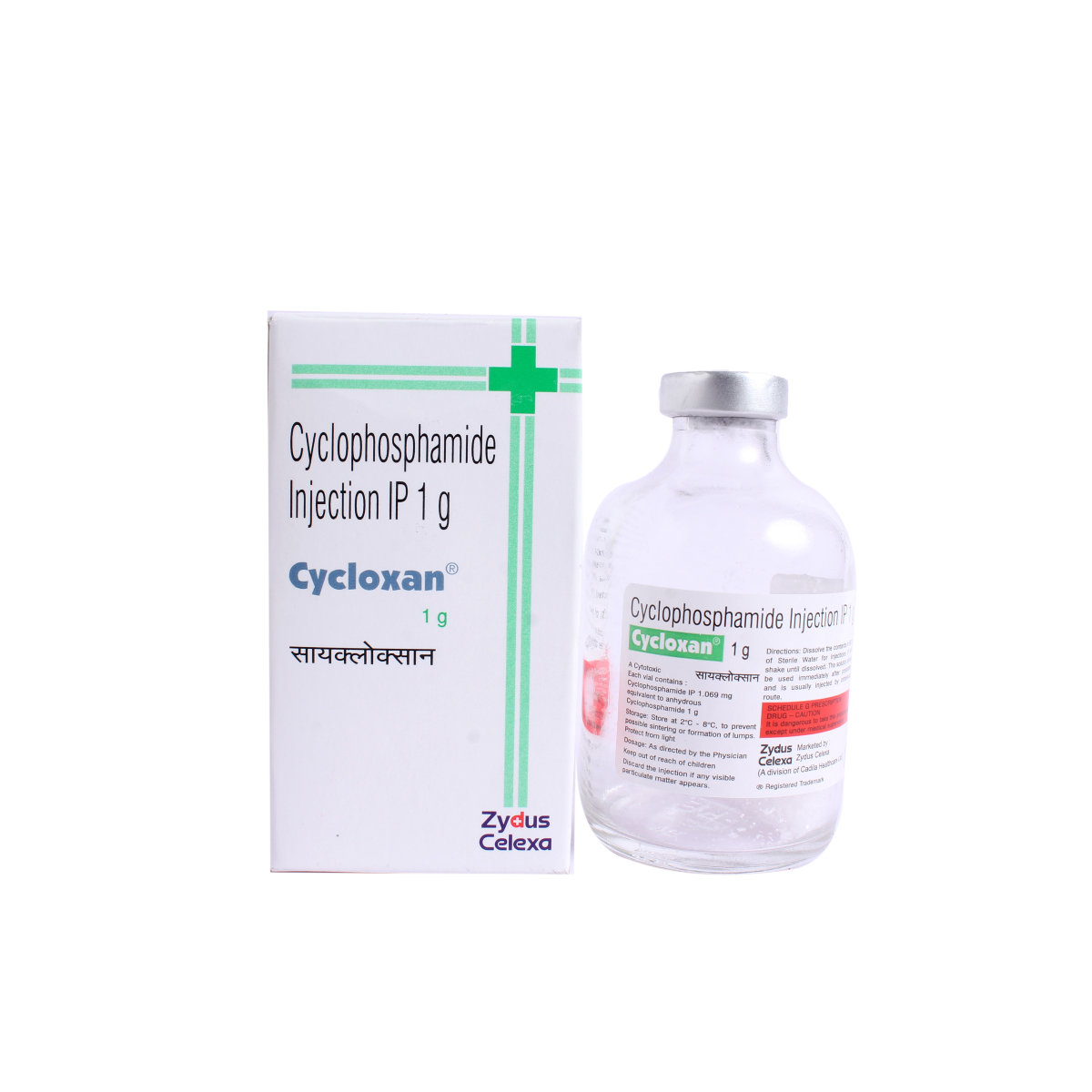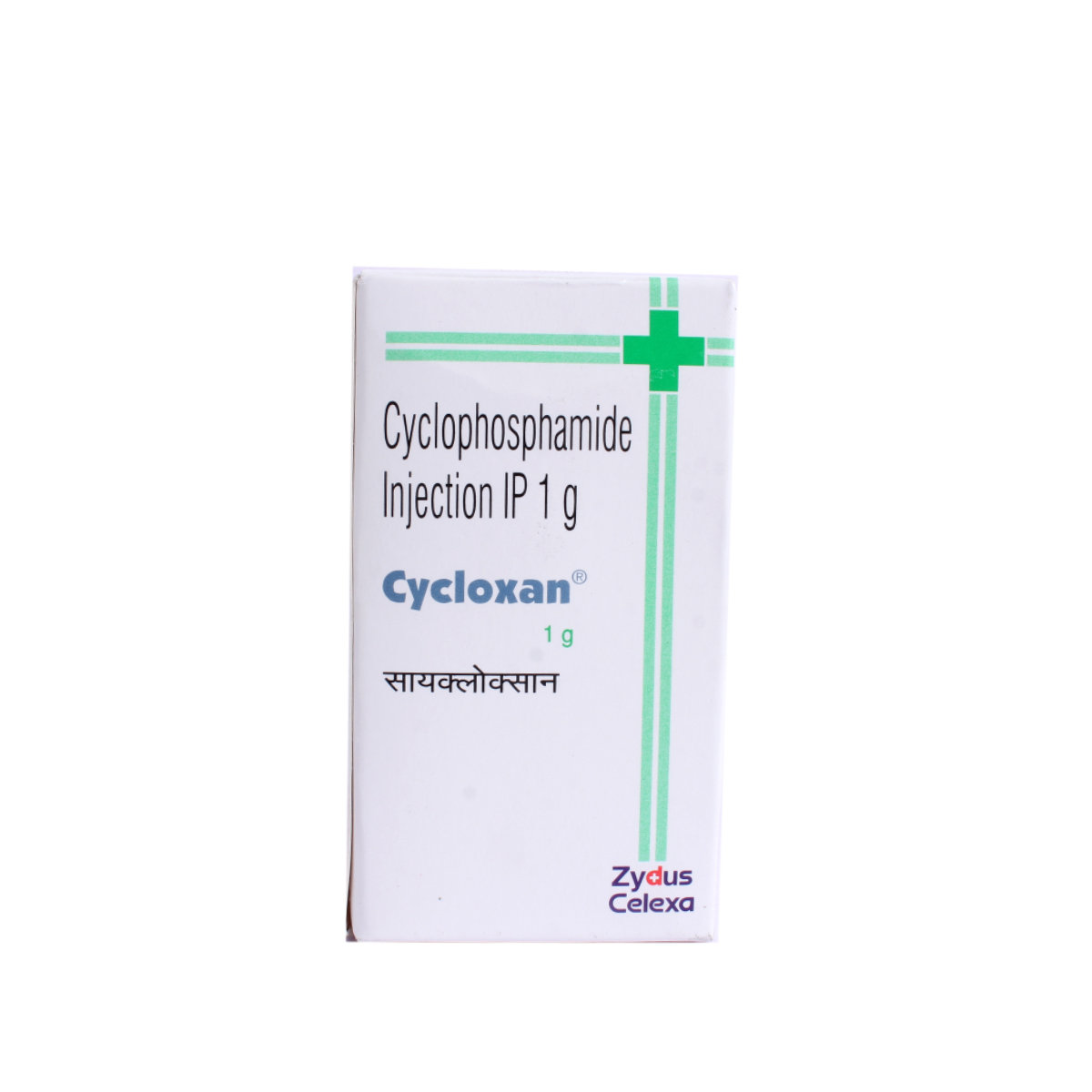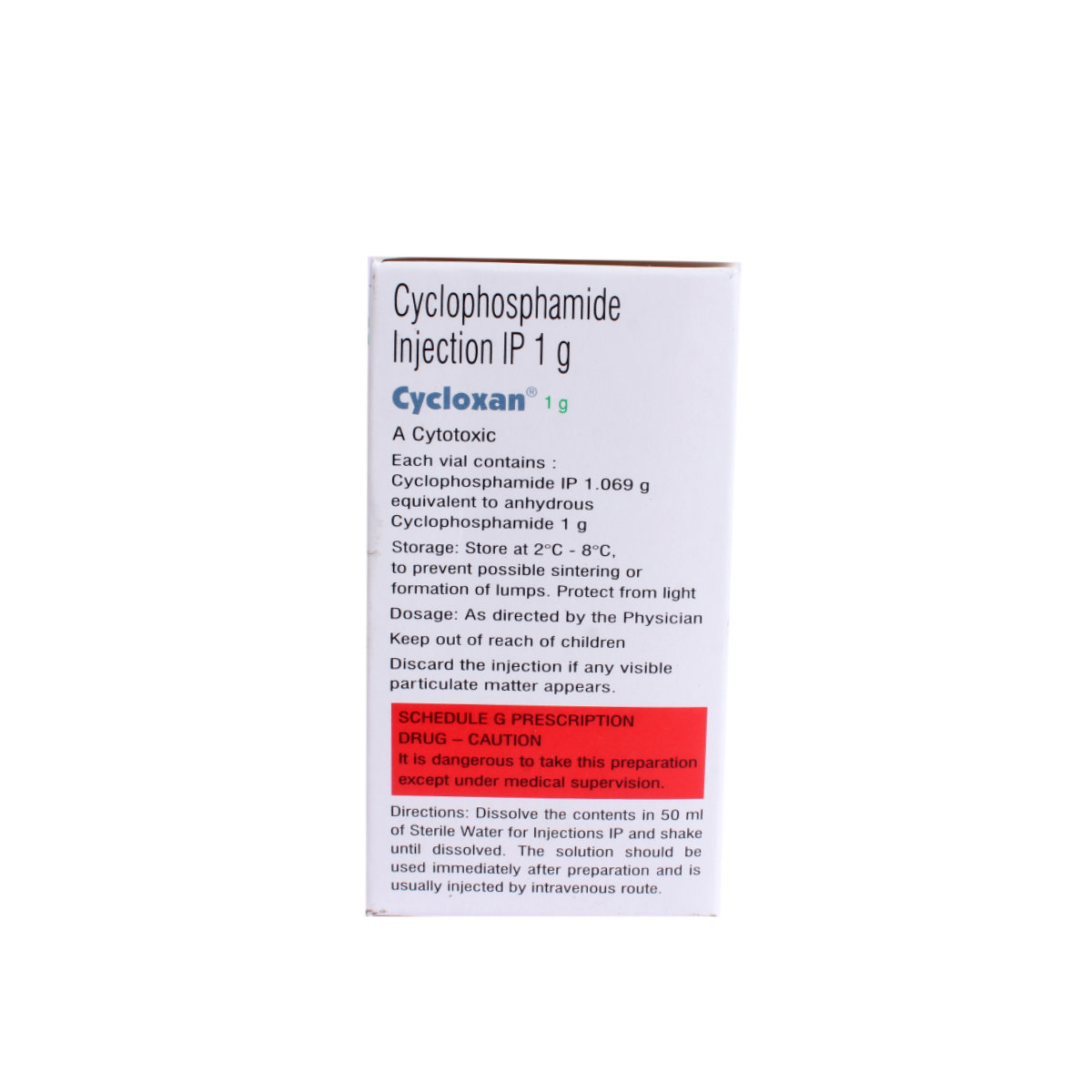CYCLOXAN INJECTION 1GM








MRP ₹184
(Inclusive of all Taxes)
₹22.1 Cashback (12%)
Provide Delivery Location
Online payment accepted
 Prescription drug
Prescription drugWhats That
Composition :
Manufacturer/Marketer :
Consume Type :
Return Policy :
Expires on or after :
About CYCLOXAN INJECTION 1GM
CYCLOXAN INJECTION 1GM belongs to the group of medicines called alkylating agents used to treat malignant diseases such as Hodgkin's disease, mixed-cell type lymphoma, lymphocytic lymphoma, histiocytic lymphoma, multiple myeloma, Burkitt's lymphoma, leukaemia, neuroblastoma, retinoblastoma, adenocarcinoma of the ovary, mycosis fungoides, Ewing's sarcoma, small cell lung cancer, advanced/metastatic neuroblastoma and breast carcinoma. Additionally, CYCLOXAN INJECTION 1GM is used to treat minimal change nephrotic syndrome (kidney disease) in paediatric patients.
CYCLOXAN INJECTION 1GM contains 'Cyclophosphamide' that works by stopping or slowing the growth of cancer cells in the body. Thereby, CYCLOXAN INJECTION 1GM helps treat cancer. CYCLOXAN INJECTION 1GM suppresses the body's immune system and helps treat nephrotic syndrome.
In some cases, CYCLOXAN INJECTION 1GM may cause nausea, vomiting, stomatitis (inflamed and sore mouth), weakness, malaise (general discomfort), fever, leukopenia (low white blood cell count), and alopecia (hair loss). You are advised to talk to your doctor if the side effects persist or worsen.
Consult your doctor if you are pregnant, planning pregnancy, or breastfeeding. CYCLOXAN INJECTION 1GM may cause dizziness, so drive only if you are alert. Inform your doctor about your health condition and medications to rule out any side effects/interactions.
Uses of CYCLOXAN INJECTION 1GM
Directions for Use
Medicinal Benefits
CYCLOXAN INJECTION 1GM belongs to the group of medicines called alkylating agents used to treat malignant diseases such as Hodgkin's disease (cancer of the lymphatic system), mixed-cell type lymphoma, lymphocytic lymphoma, histiocytic lymphoma, multiple myeloma (cancer of plasma cells), Burkitt's lymphoma, leukaemia (blood cancer), neuroblastoma (cancer commonly found in the adrenal glands), retinoblastoma (eye cancer), adenocarcinoma of the ovary, mycosis fungoides, Ewing's sarcoma (cancer in and around the bones), small cell lung cancer, advanced/metastatic neuroblastoma and breast carcinoma. CYCLOXAN INJECTION 1GM works by stopping or slowing the growth of cancer cells in the body. Thereby, CYCLOXAN INJECTION 1GM helps treat cancer. Additionally, CYCLOXAN INJECTION 1GM is used to treat minimal change nephrotic syndrome (kidney disease) in paediatric patients. CYCLOXAN INJECTION 1GM suppresses the body's immune system, thereby helping treat nephrotic syndrome.
Storage
- Eat well-cooked food to minimize infection risk.
- Practice good hand hygiene to prevent infections.
- Avoid crowds and people with illnesses to reduce exposure.
- Wear a mask when necessary to lower infection risk.
- Rest adequately to support your body's healing process.
- Stay hydrated by drinking plenty of water.
- Regularly monitor blood cell counts for changes.
- Seek immediate medical help if symptoms like fever, chills, or fatigue occur.
- Consult your doctor right away if concerning symptoms arise.
- Follow your doctor's guidance on managing myelosuppression and infection prevention.
- Your doctor may adjust the dose of the suspected medication based on your immune health; however, do not stop taking it suddenly without consulting them first.
- Wash your hands often and handle food safely to avoid germs.
- Get enough sleep and manage your stress levels to help your immune system stay strong.
- Eat a balanced diet with plenty of vegetables, fruits, whole grains, dairy, and proteins.
- Do not eat raw eggs, meat, fruits, unpasteurized milk, or uncooked vegetables.
- Stay away from crowded places and individuals who are sick.
- Have regular blood tests to check your immune system’s health.
- Keep your vaccines up-to-date and ask your doctor about which vaccines you need.
- Eat protein-rich foods like fish, poultry, eggs, and legumes.
- Include foods with minerals and vitamins essential for hair health.
- Join a support group to connect with others experiencing hair loss.
- Openly discuss your feelings about hair loss.
- Consider covering up with wigs, hats, or scarves.
- Be patient and avoid seeking miracle cures.
- Bladder infection needs immediate medical attention when you observe blood in urine or have any abnormal changes in your body.
- Get a physical examination and blood tests to identify factors that led to infection and initiate the treatment process immediately.
- Avoid anxiety and stress, as it can worsen your condition.
- Follow your doctor's instructions, and there can be medication with antibiotics and other supportive vitamins.
- Take a balanced diet to prevent negative changes in your body.
- Stay hydrated to support kidney and bladder health.
- Rest on your back as advised by your doctor.
- Limit physical strain for 1-2 weeks.
- Avoid strenuous activities like running and contact sports.
- Quit smoking to improve overall health.
- Use pain medication responsibly.
- Avoid foods that can irritate the urinary track, such as spicy or acidic foods.
- Remember to consult your doctor for personalized advice and guidance on managing your symptoms and developing a treatment plan.
- Inform your doctor immediately if you experience a fever after starting a new medication.
- Your doctor may adjust your medication regimen or dosage as needed to minimize fever symptoms.
- Monitor your body temperature to monitor fever progression.
- Drink plenty of fluids, such as water or electrolyte-rich beverages, to help your body regulate temperature.
- Get plenty of rest and engage in relaxation techniques, such as deep breathing or meditation, to help manage fever symptoms.
- Under the guidance of your doctor, consider taking medication, such as acetaminophen or ibuprofen, to help reduce fever.
- If your fever is extremely high (over 103°F), or if you experience severe symptoms such as confusion, seizures, or difficulty breathing, seek immediate medical attention.
Drug Warnings
Do not take CYCLOXAN INJECTION 1GM if you are allergic to any of its components. Inform your doctor if you have acute infections, bone marrow depression, urinary tract infections, urinary outflow/obstruction, liver or kidney problems, or urinary or respiratory symptoms. Consult your doctor if you are pregnant or breastfeeding. CYCLOXAN INJECTION 1GM may cause myelosuppression, immunosuppression, bone marrow failure, and infections; consult your doctor if you have any concerns.
Drug-Drug Interactions
Drug-Drug Interactions
Login/Sign Up
Co-administration of Nalidixic acid with Cycloxan Injection 1gm may cause an increase in the risk of side effects.
How to manage the interaction:
Co-administration of Cycloxan Injection 1gm and Nalidixic acid can lead to an interaction, it can be taken if advised by a doctor. However, if you experience any symptoms like bruising or bleeding, unusual weakness, nausea, stomach pain, low fever, or loss of appetite, consult a doctor immediately. Do not stop using any medications without a doctor's advice.
Co-administration of Cycloxan Injection 1gm and Cidofovir may increase the risk of kidney problems.
How to manage the interaction:
Taking Cyclophosphamine with Cidofovir is not recommended, please consult your doctor before taking it. However, if you experience nausea, vomiting, loss of appetite, increased or decreased urination, sudden weight gain or weight loss, swelling, shortness of breath, bone pain, muscle cramps, tiredness, weakness, dizziness, confusion, and irregular heart rhythm contact your doctor immediately. Do not discontinue any medications without consulting a doctor
Taking Lidocaine with Cycloxan Injection 1gm may increase the risk of methemoglobinemia (a rare condition that can lead to oxygen deprivation in tissues and vital organs due to reduced oxygen-carrying capacity of the blood).
How to manage the interaction:
Although there is a possible interaction, Cycloxan Injection 1gm can be taken with lidocaine if prescribed by the doctor. However, consult the doctor if you experience gray discoloration of the skin, abnormal blood coloration, nausea, headache, dizziness, lightheadedness, weakness, shortness of breath, rapid or shallow breathing, a rapid heartbeat, palpitation, anxiety, or confusion. Do not discontinue the medication without consulting a doctor.
Co-administration of Cycloxan Injection 1gm with Voclosporin can increase the risk of kidney damage.
How to manage the interaction:
Although there is a possible interaction between Cycloxan Injection 1gm and Voclosporin, you can take these medicines together if prescribed by a doctor. It's important to keep an eye on how much you pee. Some other signs to watch out for are feeling sick, throwing up, not wanting to eat, gaining or losing weight suddenly, holding onto fluids, having a fever or chills, having diarrhea or a sore throat, feeling weak or dizzy, being confused, having trouble breathing, feeling pain or a burning sensation when you pee, or having an irregular heartbeat. Do not stop using any medications without talking to a doctor.
When Cycloxan Injection 1gm is taken with Infliximab, it can increase the risk or severity of developing serious infections.
How to manage the interaction:
Although taking Infliximab and Cycloxan Injection 1gm together can cause an interaction, it can be taken if a doctor has suggested it. If you have any of these symptoms like fever, chills, diarrhea, sore throat, muscle pain, difficulty breathing, weight loss, and pain or burning when you pee, it's important to contact a doctor right away. Do not stop using any medications without talking to a doctor.
Taking Clozapine and Cycloxan Injection 1gm may increase the risk of infection.
How to manage the interaction:
Taking Cycloxan Injection 1gm with Clozapine can possibly lead to an interaction. However, they can be taken together if prescribed by the doctor. Consult the doctor if you experience signs and symptoms of infection such as fever, chills, diarrhea, sore throat, muscle aches, shortness of breath, blood in phlegm, weight loss, red or inflamed skin, body sores, and pain or burning during urination. Do not discontinue the medication without consulting a doctor.
Taking Cycloxan Injection 1gm with Leflunomide may increase the risk of serious infections.
How to manage the interaction:
Although there is a possible interaction, Cycloxan Injection 1gm can be taken with Leflunomide if prescribed by the doctor. Consult the doctor immediately if you develop signs and symptoms of infection such as fever, chills, diarrhea, sore throat, muscle aches, shortness of breath, blood in phlegm, weight loss, red or inflamed skin, body sores, and pain or burning during urination. Do not discontinue the medication without consulting a doctor.
Taking Fingolimod's ability to suppress the immune system may be enhanced by Cycloxan Injection 1gm.
How to manage the interaction:
Although taking Cycloxan Injection 1gm and Fingolimod together can evidently cause an interaction, it can be taken if a doctor has suggested it. If you have any of these symptoms, it's important to contact a doctor right away - a serious infection, problems, high body temperature, feeling cold, loose stools, a painful throat, body discomfort, difficulty breathing, losing weight, or experiencing pain or discomfort while urinating. Do not stop using any medications without a doctor's advice.
Coadministration of Tenofovir disoproxil with Cycloxan Injection 1gm may increase the risk of developing kidney problems.
How to manage the interaction:
Although there is a possible interaction, Cycloxan Injection 1gm can be taken with Tenofovir disoproxil if prescribed by the doctor. Consult the doctor if you experience signs and symptoms of kidney damage such as nausea, vomiting, loss of appetite, increased or decreased urination, sudden weight gain or weight loss, swelling, shortness of breath, bone pain, muscle cramps, tiredness, weakness, dizziness, confusion, and irregular heart rhythm. Do not stop using any medication without consulting a doctor.
Taking Cycloxan Injection 1gm with Tofacitinib may increase the risk of serious infections.
How to manage the interaction:
Although there is a possible interaction, Cycloxan Injection 1gm can be taken with Tofacitinib if prescribed by the doctor. Consult the doctor immediately if you develop signs and symptoms of infection such as fever, chills, diarrhea, sore throat, muscle aches, shortness of breath, blood in phlegm, weight loss, red or inflamed skin, body sores, and pain or burning during urination. Do not discontinue the medication without consulting a doctor.
Drug-Food Interactions
Drug-Food Interactions
Login/Sign Up
Diet & Lifestyle Advise
- Eat a healthy diet and exercise regularly to maintain proper weight.
- Avoid smoking and alcohol consumption.
- Include leafy vegetables, citrus fruits, fatty fish, berries, yoghurt, apples, peaches, cauliflower, cabbage, broccoli, beans, herbs, and spices in your food.
- Avoid fast food, fried food, processed meats, refined carbs and added sugar.
- Get optimal sleep; rest well.
Side Effects of CYCLOXAN INJECTION 1GM
- Nausea
- Vomiting
- Stomatitis (inflamed and sore mouth)
- Weakness
- Malaise (general discomfort)
- Fever
- Leukopenia (low white blood cell count)
- Alopecia (hair loss)
Habit Forming
Therapeutic Class
All Substitutes & Brand Comparisons
Author Details
We provide you with authentic, trustworthy and relevant information
Drug-Diseases Interactions
Drug-Diseases Interactions
Login/Sign Up
Cycloxan Injection 1gm usage can result in severe immunosuppression, bone marrow failure, myelosuppression (leukopenia, neutropenia, thrombocytopenia, and anaemia), and myelosuppression, which can all lead to serious and occasionally deadly infections including sepsis and septic shock. During Cycloxan Injection 1gm treatment, complete blood counts must be closely monitored in order to determine whether the dose has to be changed. Patients should not be given Cycloxan Injection 1gm if their neutrophil and platelet counts are below 1,500/mm3 and 50,000/mm3, respectively.
How to manage the interaction:
Close monitoring of complete blood count is advised during treatment with Cycloxan Injection 1gm. Inform the doctor if you notice any signs or symptoms of bone marrow suppression such as fever, sore throat, local infection, or bleeding.
Cycloxan Injection 1gm should not be administered to individuals who have any type of urine outflow restriction. Urinary blockage should be ruled out or resolved before therapy is started. During Cycloxan Injection 1gm treatment, hemorrhagic cystitis, pyelitis, and hematuria have all been mentioned.
How to manage the interaction:
Therapy with Cycloxan Injection 1gm should be administered cautiously in patients with or predisposed to bladder inflammation, including patients with active urinary infections. Urinary sediment should be monitored regularly for presence or erythrocytes and other signs of toxicity.
Cycloxan Injection 1gm should not be administered to individuals who have any type of urine outflow restriction. Urinary blockage should be ruled out or resolved before therapy is started. During Cycloxan Injection 1gm treatment, hemorrhagic cystitis, pyelitis, and hematuria have all been mentioned.
How to manage the interaction:
Therapy with Cycloxan Injection 1gm should be administered cautiously in patients with or predisposed to bladder inflammation, including patients with active urinary infections. Urinary sediment should be monitored regularly for presence or erythrocytes and other signs of toxicity.
Cycloxan Injection 1gm should not be administered to individuals who have any type of urine outflow restriction. Urinary blockage should be ruled out or resolved before therapy is started. During Cycloxan Injection 1gm treatment, hemorrhagic cystitis, pyelitis, and hematuria have all been mentioned.
How to manage the interaction:
Therapy with Cycloxan Injection 1gm should be administered cautiously in patients with or predisposed to bladder inflammation, including patients with active urinary infections. Urinary sediment should be monitored regularly for presence or erythrocytes and other signs of toxicity.
FAQs
CYCLOXAN INJECTION 1GM works by stopping or slowing down the growth of cancer cells in the body. Thereby, CYCLOXAN INJECTION 1GM helps treat cancer. CYCLOXAN INJECTION 1GM suppresses the body's immune system and helps treat nephrotic syndrome.
CYCLOXAN INJECTION 1GM might impair fertility and interfere with oogenesis (development of ovum) and spermatogenesis (development of sperm). Please consult your doctor if you have any concerns.
Men should avoid fathering a child during the treatment and for six months following discontinuation of therapy.
CYCLOXAN INJECTION 1GM might interfere with normal wound healing. Therefore, be cautious while handling sharp objects. Consult your doctor if you notice unusual bleeding or bruising or if the wounds do not heal properly.
Drug-Drug Interactions Checker List
- NATALIZUMAB
- PACLITAXEL
- ZIDOVUDINE
- AMIODARONE
- AMPHOTERICIN B
- INDOMETHACIN
- AZATHIOPRINE
- BUSULFAN
Special Advise
- Monitoring of complete blood count whilst on treatment with CYCLOXAN INJECTION 1GM is advised.
- Women of childbearing potential must use highly effective contraception during treatment and for up to 1 year after the last dose.
- Male patients who are sexually active with a female partner of child-bearing potential must use condoms during treatment and for up to 6 months after the last dose.
Disease/Condition Glossary
Cancer: It occurs due to mutations in genes that regulate cell growth. The mutations cause the cells to divide and multiply in an uncontrolled manner leading to the formation of tumours. The most common cancer treatment methods are surgery, chemotherapy, radiotherapy, bone marrow (stem cell) transplantation, immunotherapy and targeted drug therapy.
Nephrotic syndrome: It is a kidney disorder in which the body excretes too much protein in the urine. Symptoms include foamy urine, weight gain, and swelling around the eyes and in the ankles and feet.

Have a query?
Buy best Neoplastic Disorders products by
Intas Pharmaceuticals Ltd
Natco Pharma Ltd
Dr Reddy's Laboratories Ltd
Cipla Ltd
Celon Laboratories Pvt Ltd
Sun Pharmaceutical Industries Ltd
Alkem Laboratories Ltd
United Biotech Pvt Ltd
Zydus Cadila
Zydus Healthcare Ltd
Neon Laboratories Ltd
Glenmark Pharmaceuticals Ltd
Mylan Pharmaceuticals Pvt Ltd
BDR Pharmaceuticals Internationals Pvt Ltd
Emcure Pharmaceuticals Ltd
Adley Formulations
Samarth Life Sciences Pvt Ltd
Hetero Drugs Ltd
Torrent Pharmaceuticals Ltd
Fresenius Kabi India Pvt Ltd
Pfizer Ltd
Admac Lifesciences(Oncology)
Adley Pharmaceuticals Ltd
Novartis India Ltd
Halsted Pharma Pvt Ltd
Getwell Life Sciences India Pvt Ltd
Lupin Ltd
Cadila Healthcare Ltd
Hetero Healthcare Pvt Ltd
GLS Pharma Ltd
Reliance Formulation Pvt Ltd
Abbott India Ltd
Aimcad Biotech Pvt Ltd
Astra Zeneca Pharma India Ltd
Therdose Pharma Pvt Ltd
Axiommax Oncology Pvt Ltd
Biochem Pharmaceutical Industries Ltd
Khandelwal Laboratories Pvt Ltd
Msn Laboratories Pvt Ltd
Aureate Healthcare
Caitlin Oncology
Dabur India Ltd
Zee Laboratories Ltd
Sarabhai Chemicals (India) Pvt Ltd
Wembrace Biopharma Pvt Ltd
Delarc Pharmaceuticals Pvt Ltd
Medaegis Biotek Pvt Ltd
Panacea Biotec Ltd
RPG Life Sciences Ltd
Shilpa Medicare Ltd
Getwell Oncology Pvt Ltd
Ipca Laboratories Ltd
Miracalus Pharma Pvt Ltd
Biocon Ltd
Cadila Pharmaceuticals Ltd
Eli Lilly and Company (India) Pvt Ltd
Ferring Pharmaceuticals Pvt Ltd
Fresenius Kabi Oncology Ltd
Getwell Pharmaceutical Pvt Ltd
Maximal Healthcare Pvt Ltd
Boehringer Ingelheim India Pvt Ltd
Del Trade International Pvt Ltd
Sayre Therapeutics Pvt Ltd
Akumentis Healthcare Ltd
Corona Remedies Pvt Ltd
Eisai Pharmaceuticals India Pvt Ltd
GlaxoSmithKline Pharmaceuticals Ltd
Hilfen Pharmaceuticals Pvt Ltd
Johnson & Johnson Pvt Ltd
Mankind Pharma Pvt Ltd
Merck Ltd
Oncostar Pharma Pvt Ltd
Rhone Poulenc Rorer India Pvt Ltd
Vhb Life Sciences Inc
Zuventus Healthcare Ltd
Admac Pharma Ltd
Adonis Laboratories Pvt Ltd
Alniche Life Sciences Pvt Ltd
BPRL Pvt Ltd
Caitlin Life Care
Dr Care
German Remedies Ltd
Janssen Pharmaceuticals Pvt Ltd
MEDICAMEN BIOTECH LTD
Maxis Healthcare (I) Pvt Ltd
Pharm Products Pvt Ltd
Accord Life Spec Pvt Ltd
Amps Biotech Biotech Pvt Ltd
Aphia Healthcare
Astellas Pharma India Pvt Ltd
Bangalore Pharmaceutical and Research Laboratory Pvt Ltd (BPRL)
Bharat Serums and Vaccines Ltd
Cellgen Biopharma
Cosmic Life Sciences
Daris Biocare
East West Pharma India Pvt Ltd
Hillrock Biotech Pvt Ltd
Lucien Life Sciences
Maneesh Pharmaceuticals Ltd
Medilief Bioscience Pvt Ltd
Alcohol
Caution
You are recommended to avoid alcohol consumption as it may worsen the risk of cyclophosphamide-induced nausea and vomiting.
Pregnancy
Caution
It is not recommended for use in pregnancy as it may harm your foetus. Hence, if you are pregnant or planning pregnancy, inform your doctor before receiving CYCLOXAN INJECTION 1GM. Your doctor may prescribe this medicine only if the benefits outweigh the risks.
Breast Feeding
Unsafe
It is not recommended for use in breastfeeding as it may pass into breast milk and harm your infant. Hence, if you are breastfeeding, inform your doctor before receiving CYCLOXAN INJECTION 1GM. Avoid breastfeeding during treatment with CYCLOXAN INJECTION 1GM and for one week after the last dose.
Driving
Caution
CYCLOXAN INJECTION 1GM may cause dizziness. Do not drive or operate heavy machinery until you are alert.
Liver
Caution
If you have a pre-existing or a history of liver disease, inform your doctor before receiving CYCLOXAN INJECTION 1GM. Your doctor may adjust the dose of this medicine or prescribe a suitable alternative based on your condition.
Kidney
Caution
If you have a history of kidney diseases, inform your doctor before receiving CYCLOXAN INJECTION 1GM. Your doctor may adjust the dose of this medicine or prescribe a suitable alternative based on your condition.
Children
Consult your doctor
Please consult your doctor. Your doctor will with the benefits and risks before prescribing this medicine based on your child's medical condition.



_0.jpg?tr=q-85)

